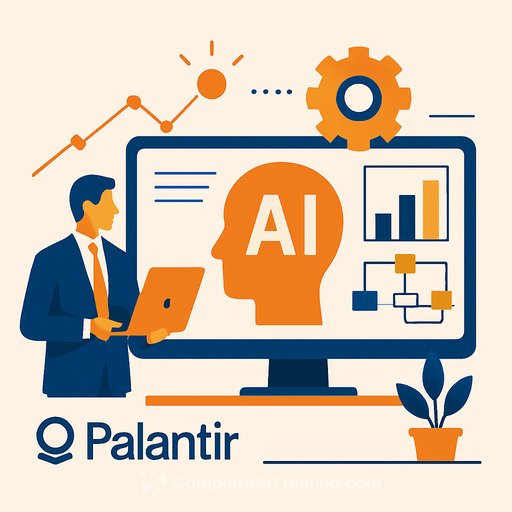Palantir Technologies: How AIP's Operational AI Supports Its Premium Valuation
Palantir Technologies has often been seen as a controversial stock, trading at valuations that many find hard to justify by traditional standards. However, with Q2 2025 results on the horizon, the focus is shifting. The Artificial Intelligence Platform (AIP), launched in 2023, is now central to Palantir's transformation and offers a strong rationale for its high valuation.
AIP: Focusing on Operational AI, Not Just AI Models
The AI market in 2025 is crowded with generative AI tools, cloud services, and open-source models. Palantir’s AIP stands apart by targeting the operationalization of AI, a market estimated to exceed $100 billion. Instead of competing on model training or raw compute, AIP embeds AI into mission-critical workflows while ensuring governance, security, and human oversight remain intact.
The platform’s architecture is key. AIP integrates third-party large language models (LLMs) like OpenAI and Anthropic within a secure, auditable environment. This allows enterprises to deploy AI on private data without risking exposure of sensitive information. This is especially important in sectors like defense, healthcare, and finance where compliance and risk management are essential.
AIP’s “human-in-the-loop” model requires explicit human approval for high-impact decisions such as military targeting or large financial trades. This approach directly addresses concerns about AI unpredictability in critical operations.
Another important feature is AIP’s Ontology—a semantic layer that connects data to operational workflows. Commands like “increase production at Plant A” trigger a series of analyses across inventory, staffing, and logistics, turning raw data into actionable intelligence. This makes AIP vital for organizations aiming to optimize complex systems.
Revenue Growth and Financial Impact of AIP
AIP is already fueling Palantir’s financial growth. The U.S. commercial segment grew 71% year-over-year in Q1 2025, driven by contracts such as BP’s $400 million multi-year deal. Rapid deployment of the platform—often within days—has shortened Palantir’s sales cycle. The AIP Bootcamp, which allows clients to test the platform with their own data, has been instrumental. In Q1 2025, Palantir closed 139 deals exceeding $1 million each, with 31 deals over $10 million.
Financially, AIP is proving profitable. Operating margins improved to 10.83% in 2024, and net income increased 120% to $462 million. Analysts forecast revenue growth from $2.81 billion in 2024 to $6.51 billion by 2027, representing a 30.87% compound annual growth rate. This is supported by AIP’s high-margin model; once deployed, it requires minimal ongoing engineering support compared to traditional Palantir tools.
Why Palantir’s Premium Valuation Makes Sense
Palantir’s valuation metrics—trailing P/E of 663x and forward P/E of 252x—raise questions. Yet, AIP’s defensibility and sustainability provide a solid case for this premium. Three factors stand out:
- Security and Compliance: Palantir’s background in intelligence grants it elite security certifications such as DISA IL6. This creates a high barrier to entry in defense and intelligence contracts. As secure AI becomes a priority for governments and corporations, this advantage grows.
- Network Effects: AIP works with Palantir’s existing platforms, Foundry and Gotham, forming a closed system where data, analytics, and operations reinforce each other. The more a customer uses AIP, the more integral it becomes to their operations.
- Strategic Partnerships: Collaborations with system integrators like Accenture speed up adoption while managing risks of revenue dilution. Though profits are shared, these partnerships extend Palantir’s market reach and balance growth with margin preservation.
Risks and What Lies Ahead
A high valuation means Palantir must consistently deliver. Key risks include:
- Government Competition: The U.S. Defense Department’s move toward multi-vendor AI contracts with players like OpenAI and Google could pressure margins.
- Profitability Challenges: Increased partnerships and rising R&D expenses (up 25.51% in 2024) might temporarily reduce margins.
- Execution Risks: Maintaining AIP’s first-mover advantage in operational AI is critical for long-term success.
Investment Perspective: Buy for the AI Era’s Control Layer
Palantir’s AIP is not a short-term trend. It functions as the operating system for AI-powered enterprises, especially in high-stakes, high-margin industries. By securing a niche in the “activation layer” of the AI stack, Palantir gains a competitive position difficult to replicate.
While the valuation is high, Palantir’s ability to sustain 70%+ commercial growth and maintain profitability despite partnerships offers some safety. The question for investors is whether AIP can scale its success further. If executed well, the platform could generate $100 billion in revenue by 2030—a 25-fold increase from 2025.
Given the lack of comparable alternatives in operational AI, this scenario appears achievable.
Recommendation: Consider buying for long-term AI exposure. A 12-month price target of $130 accounts for potential valuation adjustments, reflecting a 15% discount to current levels.
Your membership also unlocks:






